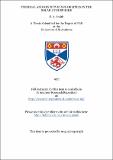Thermal and resistive instabilities in the solar atmosphere
Abstract
The magnetic field greatly influences the plasma in the solar atmosphere and in this thesis we consider the effect of the field on the stability of the plasma. The many observations that have been made suggest that two types of field structure play a major role. Firstly a current sheet - this has field lines which change direction in a thin, current forming region, but are fairly uniform outside. We consider the case where the field strength is zero along the neutral line so that a gas pressure gradient is required across the sheet to balance the magnetic pressure gradient. Secondly a force-free field - here the magnetic force is zero, which requires the magnetic pressure to be much larger than the gas pressure. In the neutral current sheet we examine the thermal instability and the tearing-mode instability. While in the force-free magnetic arch system we look for a thermal instability which can occur when the foot points of the arch are sheared. When we investigated the thermal stability of the current sheet we found that as its length increases it passes through a series of stable equilibria until a value, L[sub]max, is reached when the sheet cools down to a max new stable equilibrium. For coronal conditions, values for L[sub]max and max cooling time are in fair agreement with the observed values for quiescent prominences. We calculate the growth rate of the tearing-mode instability in a neutral current sheet with no energy sources or sinks and find that the maximum growth rate can be significantly larger in the current sheet than in the sheared field of constant magnitude considered by others. Also the growth rate decreases when the ratio of gas to magnetic pressure is reduced. We find that the growth rate is significantly inhibited if the current sheet has a transverse magnetic field which is large enough. Lastly we examine the thermal balance in a sheared, force-free magnetic field and show that thermal instability can occur if the field is sheared enough. We assume thermal equilibrium between radiative loss and thermal conduction and we take gravity balanced by a pressure gradient. If, for example, the density at the base of the field is ten times larger than the normal coronal value, as it may be in coronal condensations, then there is instability if the shear angle is greater than 63 °. The presence of a large enough mechanical heating is found to prevent the instability occurring.
Type
Thesis, PhD Doctor of Philosophy
Collections
Items in the St Andrews Research Repository are protected by copyright, with all rights reserved, unless otherwise indicated.

